Argentina will be looking to go past the group stage of the FIFA Women’s World Cup for the first time at this summer’s tournament. The side who are ranked 28th in the world have never reached the knockout stages of the competition in their three previous attempts, falling at the group stage in the 2003, 2007, and 2019 editions. With the side coached by Germán Portanova still searching for their first World Cup finals victory, it seems extremely unlikely that Argentina will follow in the footsteps of the men’s side, who won their own World Cup last year, captained by Lionel Messi, who is on his way to the MLS to join Inter Miami after his departure from PSG.
Argentina head into the World Cup in good form, going unbeaten in their last five matches in regular time — only losing on penalties to Venezuela in April. Argentina are in Group G with Sweden, who are currently ranked third in the world. Italy and South Africa may represent more realistic prospects of picking up points, with these sides ranked 16th and 54th respectively.
This scout report will provide an analysis of Argentina’s squad going into the tournament. It will also provide a tactical analysis of the tactics that Argentina will look to use, as well as help form a prediction of how far into the tournament they may go.
Predicted starting XI
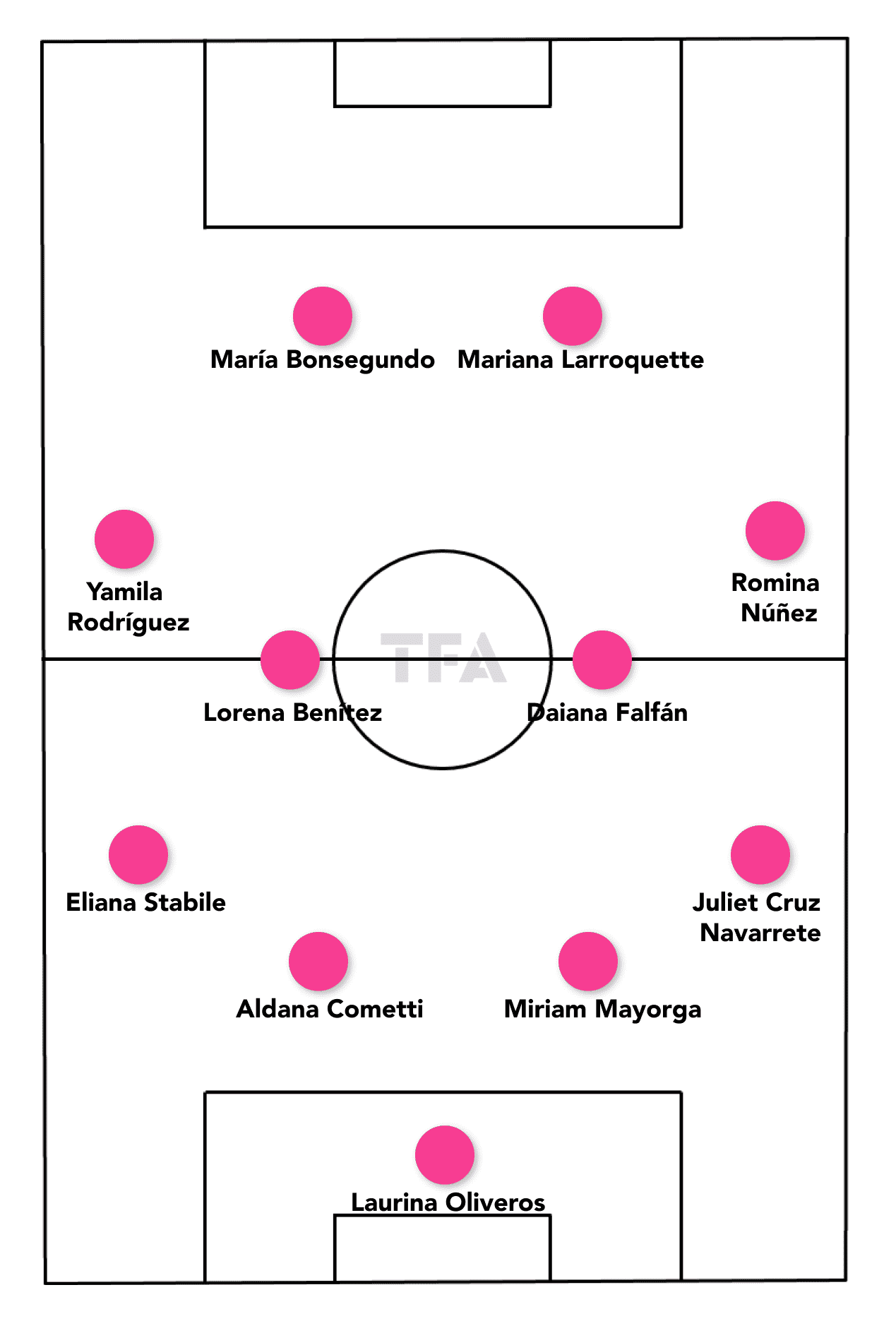
Argentina tend to line up in a 4-4-2 formation, although they can also go with a 4-2-3-1 shape. Assuming they go with their 4-4-2 formation, as we can see from the above image, in goal they will be expected to go with Laurina Oliveros. A regular centre-back pairing of Miriam Mayorga and Aldana Cometti will play ahead of her. Julieta Cruz Navarrete will likely play on the right side of the defence, while Eliana Stabile should line up at left-back. In the middle of the pitch, Daiana Falfán and Lorena Benítez usually play alongside each other. Romina Núñez will likely play on the right side of midfield, while Yamila Rodríguez should feature on the left. In attack, Mariana Larroquette is expected to partner María Bonsegundo up front, although the former is also able to drop slightly deeper.
When we look at the squad age profile using the below image, we can see how Argentina’s squad has a nice mix of youth and experience, with several players falling into the mid-range of being aged between 24 and 30 years old.
They will have several players who were part of the 2019 squad that dropped out of the competition in the group stage. Despite exiting that particular competition without a victory, Argentina did manage to get their first-ever World Cup point. These mixed experiences will be useful for both boosting morale within the current squad, as well as drawing upon mistakes that were made to ensure they have the best possible chance of qualifying for the knockout stage this time around.
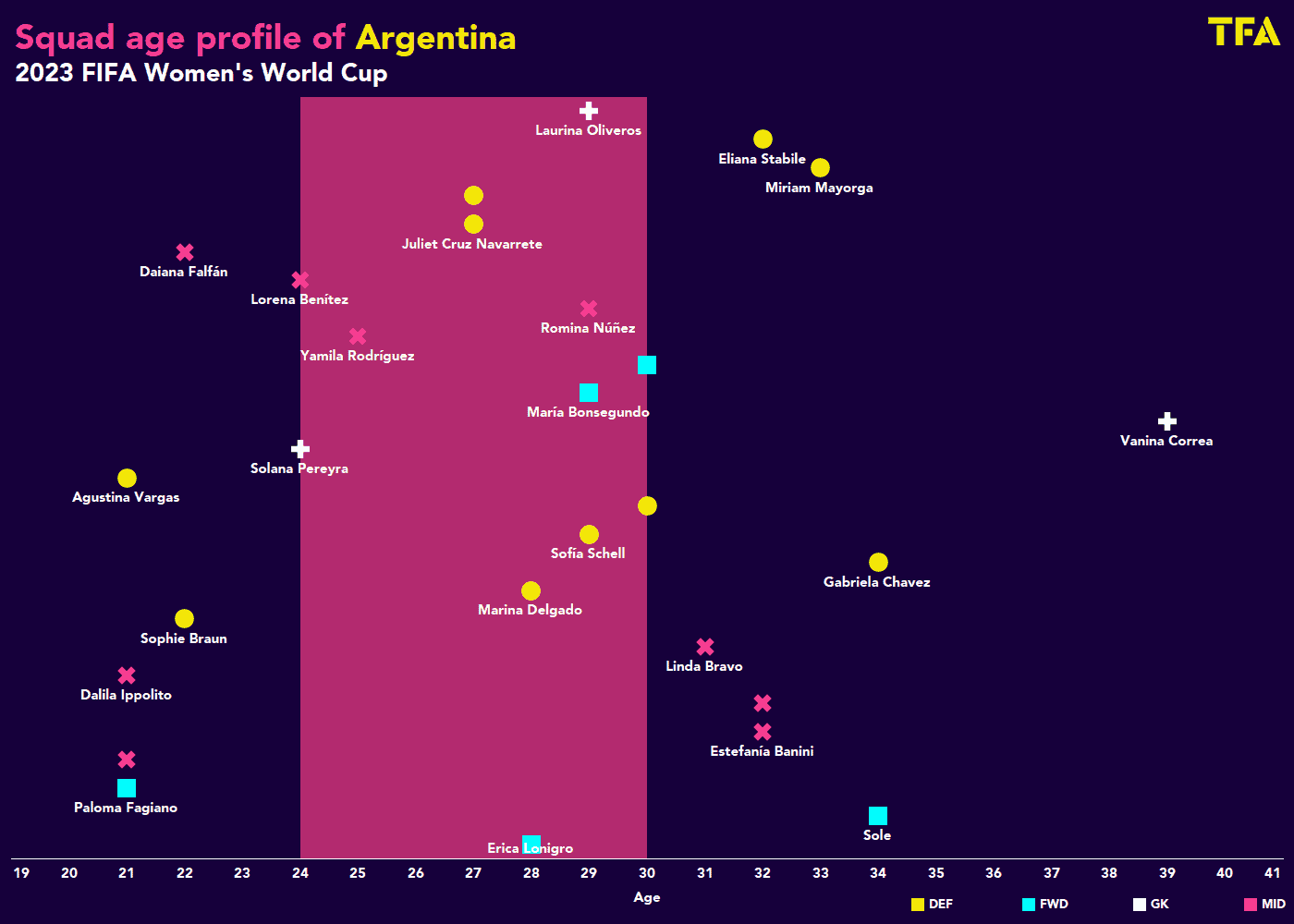
Attacking phase
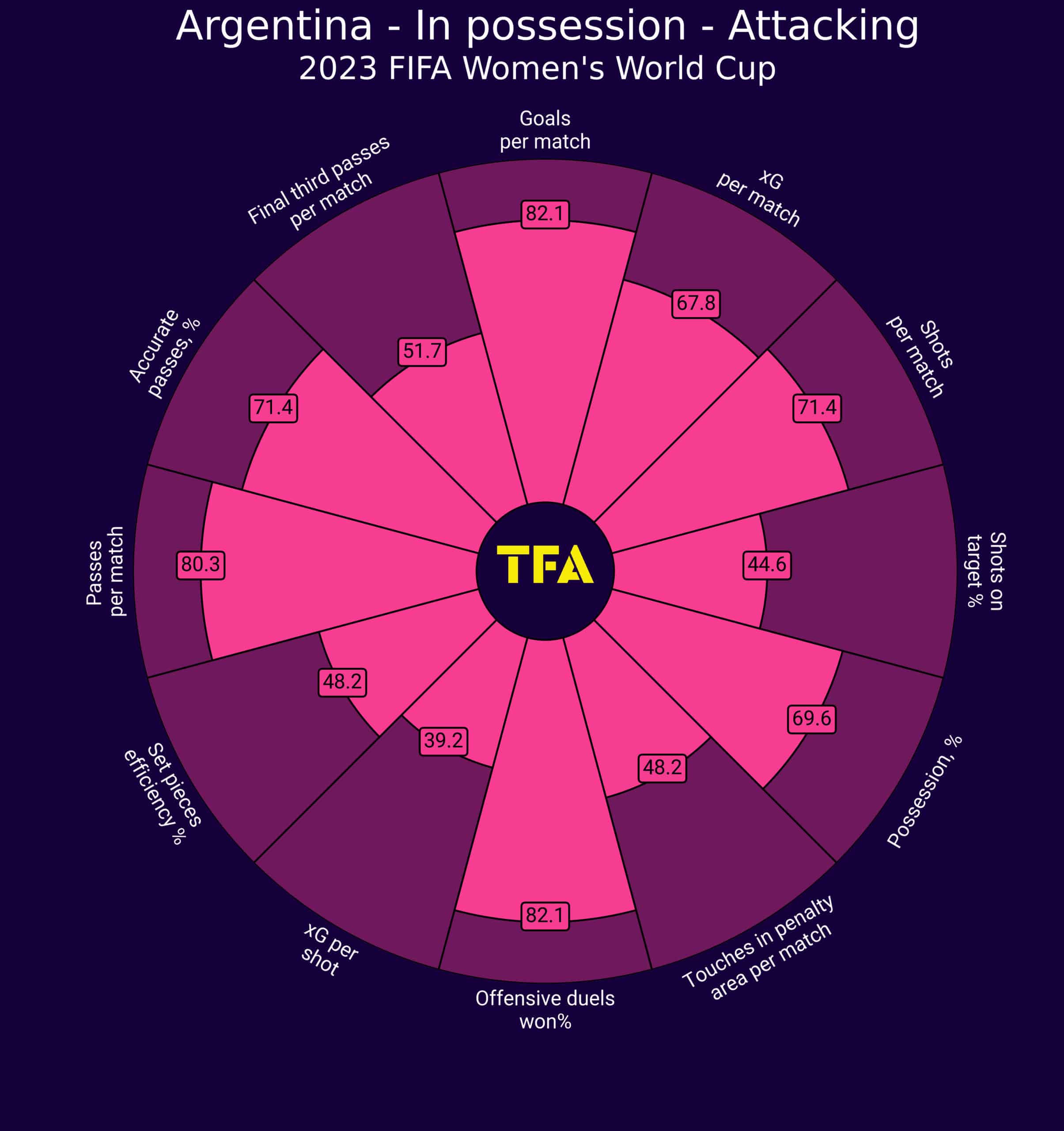
The above pizza chart provides an analysis of Argentina’s in-possession statistics. Straight away, we can see how they scored a lot of goals compared to other sides, which is no surprise considering they managed to qualify for the tournament by finishing in third place in the 2022 Copa América Femenina. They do, however, rank slightly worse for expected goals (xG).
When we look at the average xG that they generate per shot, it is quite low which suggests that they have some difficulty in creating high-quality goalscoring opportunities compared to other sides. This is backed up when we consider that they manage a below-average amount of touches in the opposition’s penalty area per match. This suggests that they take a lot of shots from further away from the opponent’s goal, where there is obviously a lower probability of turning these shots into goals. This is further supported when we consider that Argentina rank below average at getting their shots on target. By shooting from further out, it is obviously more difficult to hit the target.
So why might this be the case? When we go back to the pizza chart, it seems that Argentina like to have a high possession share and successfully attempt a high number of passes. Therefore, it seems that Argentina tend to enjoy controlling possession when they can. This, however, comes at a price. They seem to have some difficulty in turning their possession into high-quality goalscoring opportunities.
When we look at how Argentina build play from defence using their 4-4-2 formation, using the below screenshot, we can see that they are comfortable letting their goalkeeper be used during the build-up phase. We can also see that they tend to drop one of their central midfielders deeper to collect the ball from their centre-backs or, on this occasion, their goalkeeper.
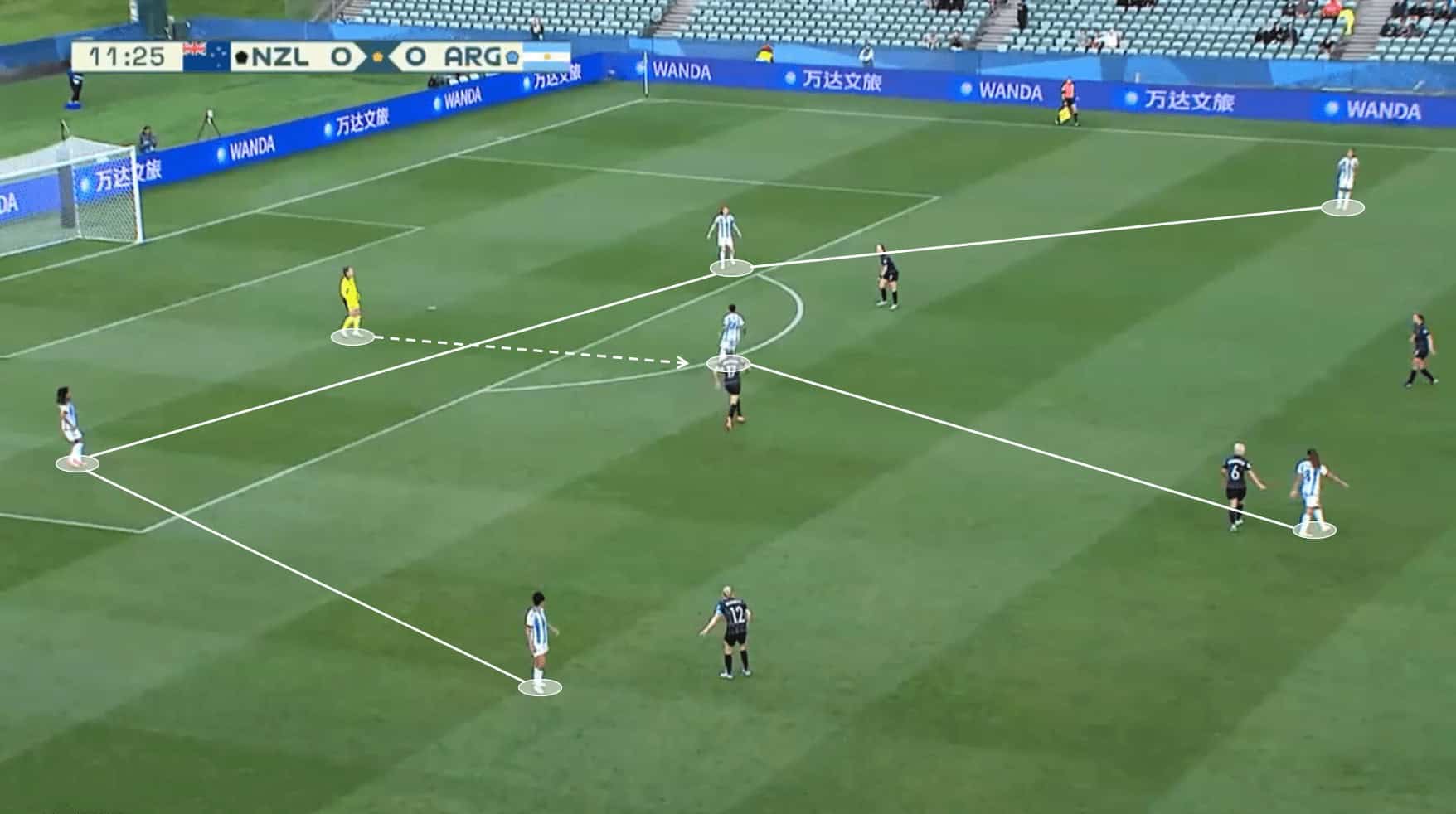
Once they have progressed play to the final third, Argentina look to push one of their full-backs forward to support the attack. This means that by tucking their near-side winger inside the pitch and getting the winger on the opposite side to attack the back post, they can get four players into the penalty area to aim the cross towards. This is illustrated through the below screenshot.
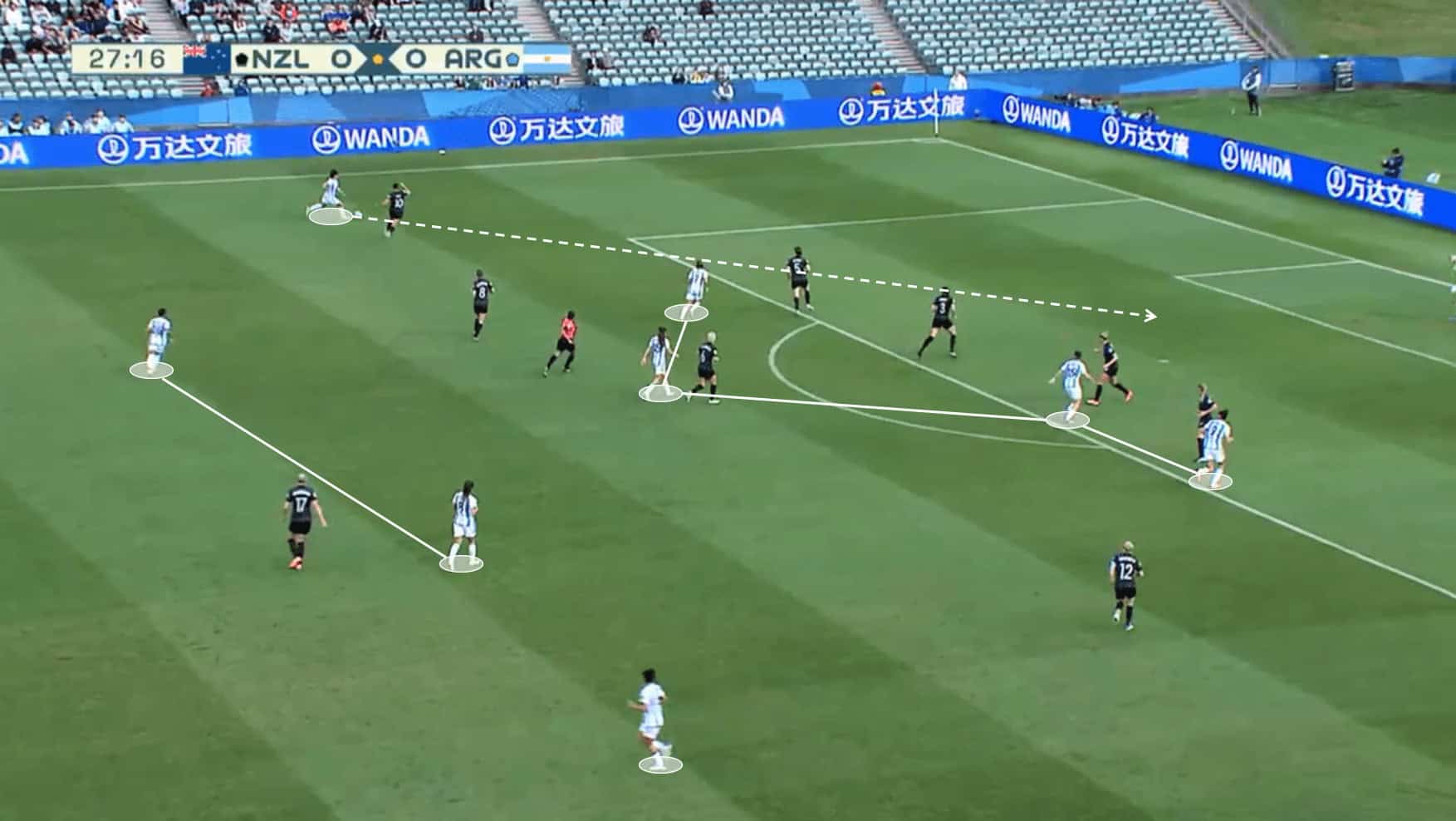
Argentina make sure that their central midfielders and full-back on the opposite side of the pitch remain deeper to mitigate the threat of opposition turnovers of possession.
Defensive phase
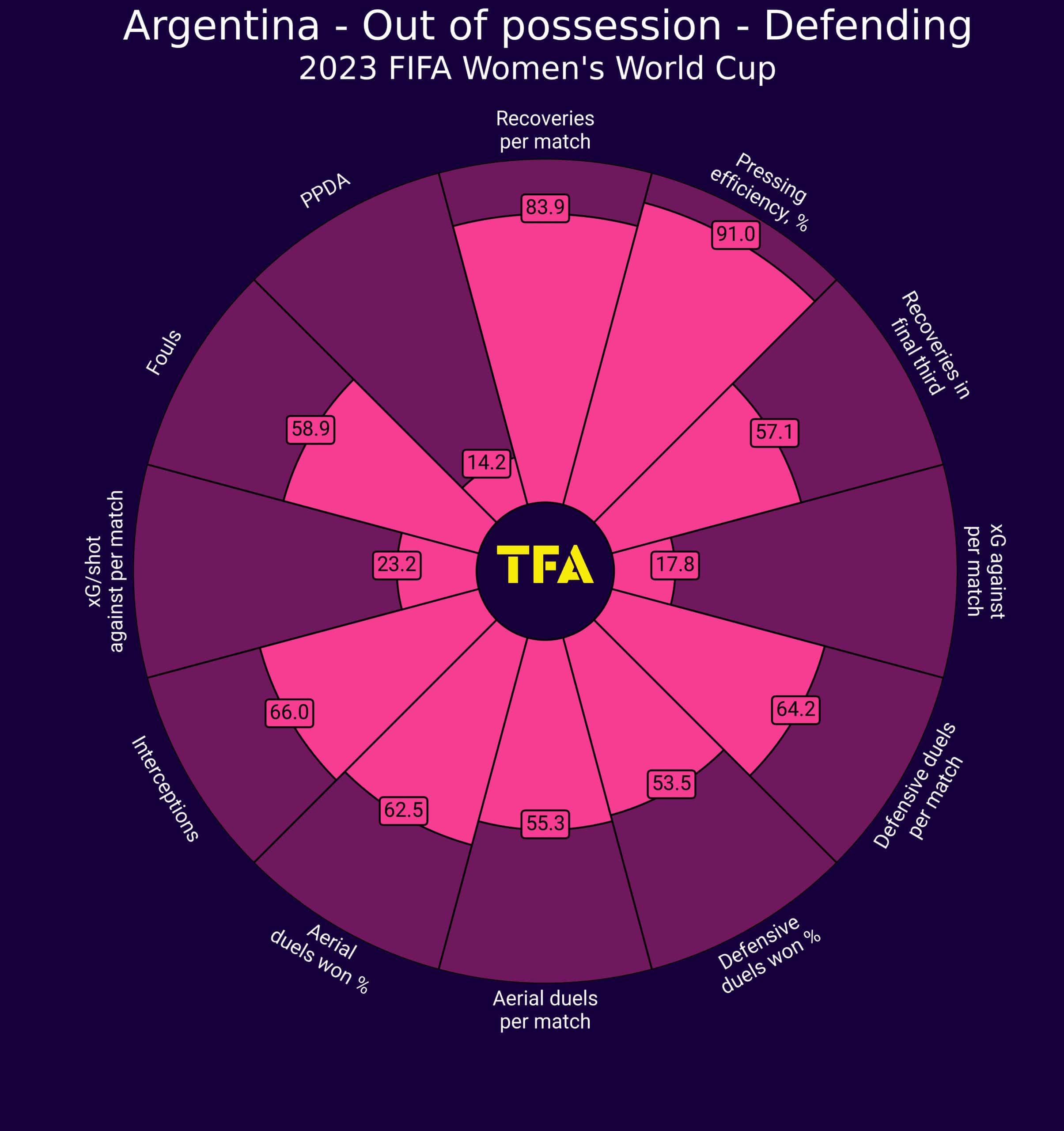
Above we can see Argentina’s out-of-possession statistics. We can clearly see that they employ an effective high press, illustrated by their low PPDA (passes per defensive action) and high pressing efficiency ratings.
We can also see from the above that Argentina make a very high number of recoveries per match but just an average amount of recoveries in the final third. This suggests that they look to cut off the passing lanes during the opposition’s build-up, forcing them into playing long passes where Argentina can then regain possession in the two-thirds of the pitch closest to their own goal.
This can be illustrated through the next couple of screenshots. First, we can see Argentina in their 4-4-2 mid-block. New Zealand have possession in their defence, and Argentina’s strikers are closer to New Zealand’s centre midfielders rather than their centre-backs. This supports the idea that Argentina look to cut off the opposition’s passing lanes to teammates.
With the ball on New Zealand’s right, Argentina shift to their left. Notice how every New Zealand player close by has an Argentina player in close proximity — other than the centre-backs. To attempt a forward pass, the New Zealand right back is forced to look for a teammate by passing the ball down the line. This is, however, not accurate enough, and Argentina can regain possession.
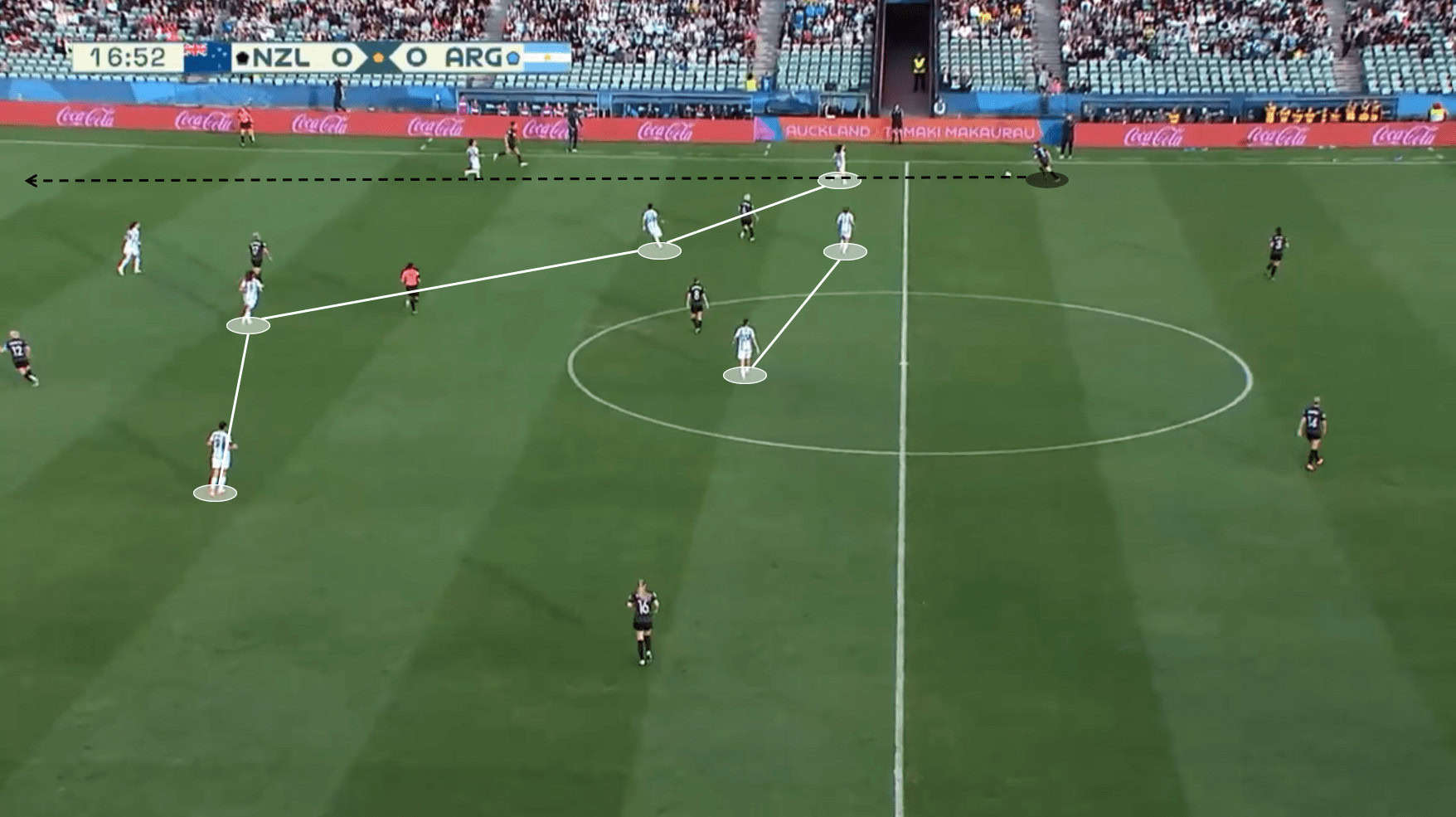
In our next example, we can see Argentina being passive in the high press by sitting in a compact mid-block. On this occasion, the New Zealand player tries a risky cross-field pass that leads to a loss of possession for her side.
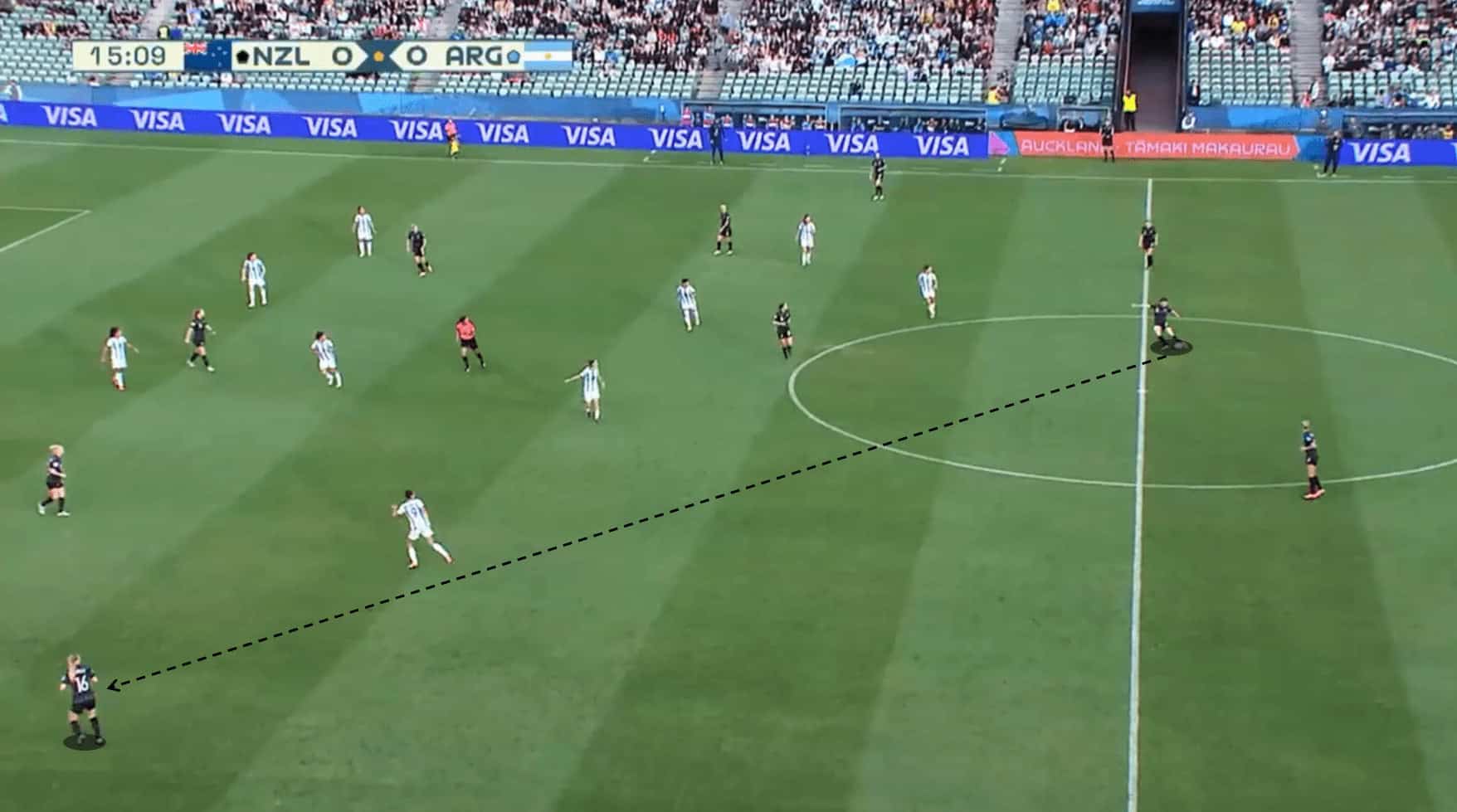
Transitions
So what about in transition? Argentina can use their out-of-possession energy to win possession back and then transition into attack quickly. In this instance, after Argentina had turned possession over after New Zealand’s cross-field pass, they were able to attack with a front four; their two strikers and two wingers. Similar to what was mentioned in the attack phase section, Argentina kept their two central midfielders deeper rather than getting forwards quickly to support the attack. On this occasion, the through pass was slightly over-hit, and New Zealand’s goalkeeper could come out of the penalty area to rescue her team.
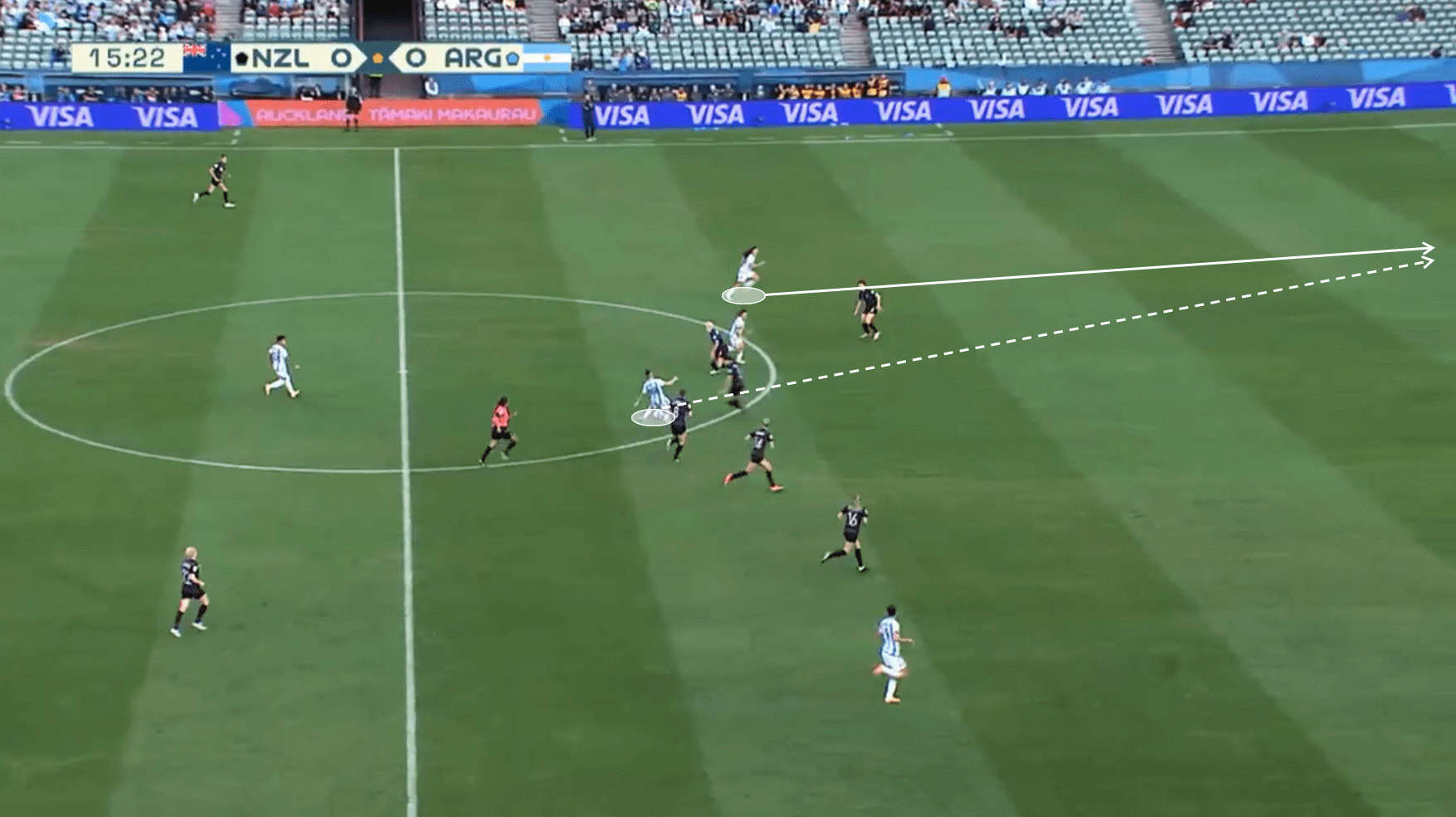
As we have mentioned before, Argentina look to keep at least one of their full-backs deeper to help to mitigate the threat of opposition turnovers of possession. When losing possession, they look to force the opponents into the wide areas where their full-back can move out to the touchline to defend. This allows both of their centre-backs to remain central rather than having to defend the wide areas. If their full-back is successful in being able to slow the attack down, it gives time for their other player who were committed to the attack to get back. This can be seen in the below screenshot.
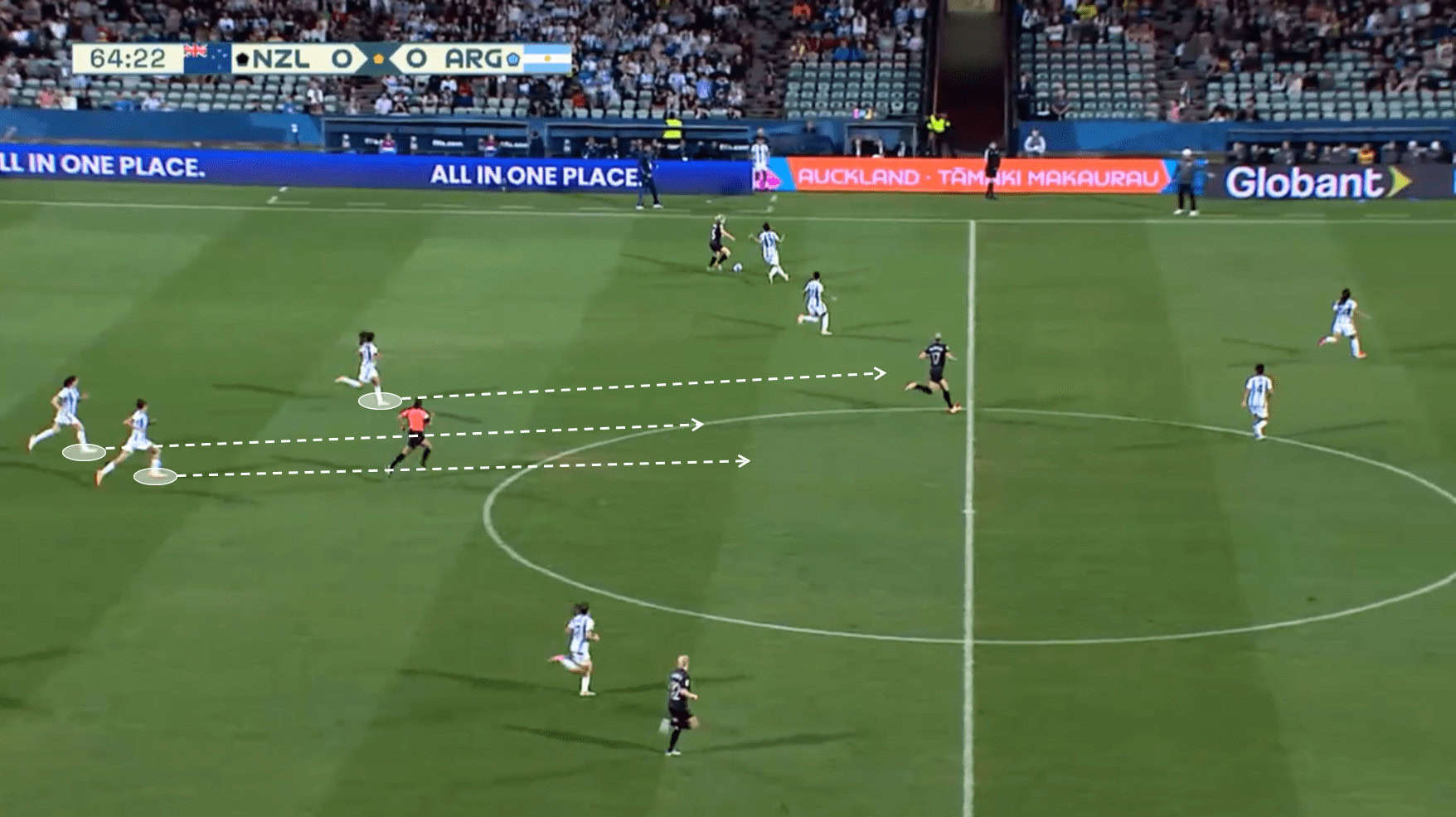
Defenders
Julieta Cruz Navarrete, who we expect to start for Argentina at right back, wins 68.8% of her defensive duels and 83.3% of her aerial duels. This will be very useful in helping Argentina keep the threat of opposition attacks at a premium. She also completes 72.6% of her attempted passes and 62.8% of her forward passes. This fits in with Argentina’s need for keeping possession and shows that she can also progress the ball effectively. Further up the pitch, Cruz Navarrete completes 50% of her attempted crosses, showing that she can be helpful in presenting Argentina’s forwards with goalscoring opportunities.
Gabriela Chavez, who is another potential right-back option for Argentina, wins a similar 63.8% of her defensive duels but only 53.8% of her aerial duels. She completes 66.2% of her passes and a similar 62.5% of her forward passes. Finally, Chavez only successfully completes 33.3% of her crosses compared to Cruz Navarrete. The 34-year-old’s statistics aren’t quite as impressive as the first-choice option, but she will provide good experience for the squad and is a steady replacement.
Regular centre-back pairing Miriam Mayorga and Aldana Cometti will be expected to play next to each other at the heart of the defence. Mayorga wins 69.6% of her defensive duels and 40.6% of her aerial duels, whilst Cometti wins an impressive 71.7% of her defensive duels and 54.2% of her aerial duels. Lastly, Mayorga has a 78.4% pass completion rate, with Cometti at 76.5%.
With Argentina only conceding one goal in their last five matches, the pair’s experience will be crucial to ensuring their side stay in matches to give them the best possible chance of picking up points to progress to the next stage of the competition. Against group favourites Sweden, for example, Argentina may have little possession and a lot of defensive work to get through. With Mayorga and Cometti both featuring heavily at Argentina’s last World Cup, their experience will also be useful. Cometti has also scored two goals in Argentina’s last five matches and will be a threat from set-pieces.
Midfielders
Daiana Falfán will be expected to start in centre midfield and will provide the defence with protection from the centre of midfield. Falfán wins 64.1% of her defensive duels and makes 5.54 interceptions per 90 minutes. She also completes a very impressive 82.8% of her passes, and at 22 years old, will bring youthfulness to this Argentina side. Although she may not have featured at the 2019 World Cup, she did play six matches at last year’s Copa América Femenina, so she will have some tournament experience despite her young age.
Romina Núñez will likely play on the right side of the midfield. Núñez completes 2.75 dribbles per match and wins 45.9% of her offensive duels. She also completes 43.8% of her crosses and gets 46.4% of her shots on target. Out of possession, Núñez wins an impressive 54.7% of her defensive duels and is also able to play at left back in Argentina’s 4-4-2 or 4-2-3-1 formation. The 29-year-old also makes 7.27 recoveries in the opposition’s half per 90 minutes.
Yamila Rodríguez can play on either side of Argentina’s midfield, and in 2023 has scored 0.45 goals per 90 minutes from an xG of 0.56. She has also made 0.45 assists per 90 minutes against an expected figure of 0.27. If selected, Rodríguez will be a goal threat for Argentina. She gets 55.53% of her shots on target and completes 56% of her crosses, and attempts 4.49 passes to the opposition penalty area.
Attackers
Mariana Larroquette is expected to partner María Bonsegundo up front for Argentina, although Larroquette is also able to play either as a #10 or on the wing instead. With both players featuring at the 2019 World Cup and 2022 Copa América Femenina, they both bring valuable tournament experience to the attack.
Larroquette scores 0.31 goals per 90 minutes from an xG of 0.33 and gets 44.4% of her shots on target. She also manages 2.92 touches of the ball in the opponent’s penalty area per 90 minutes and has scored three goals in Argentina’s last five matches. Bonsegundo scores 0.21 goals per 90 minutes from an xG of 0.18 and gets 42.1% of her shots on target. She wins 40.9% of her aerial duels and takes 1.68 touches in the opponent’s penalty area. Bonsegundo has also scored two goals in Argentina’s last five matches.
34-year-old Sole is another option in attack. Sole scores 0.30 goals per 90 minutes from an xG of 0.46 and gets 43.7% of her shots on target. Sole wins 48.5% of her aerial duels and manages 3.8 touches in the opponent’s penalty area. 21-year-old Paloma Fagiano will provide Argentina’s attack with youth at her first international tournament. The Millonarios striker scores 0.15 goals per 90 minutes from an xG of 0.32 – somewhat underperforming in front of goal so far. Despite this, she still gets 40% of her shots on target and manages 2.24 touches in the opponent’s penalty area.
Key player
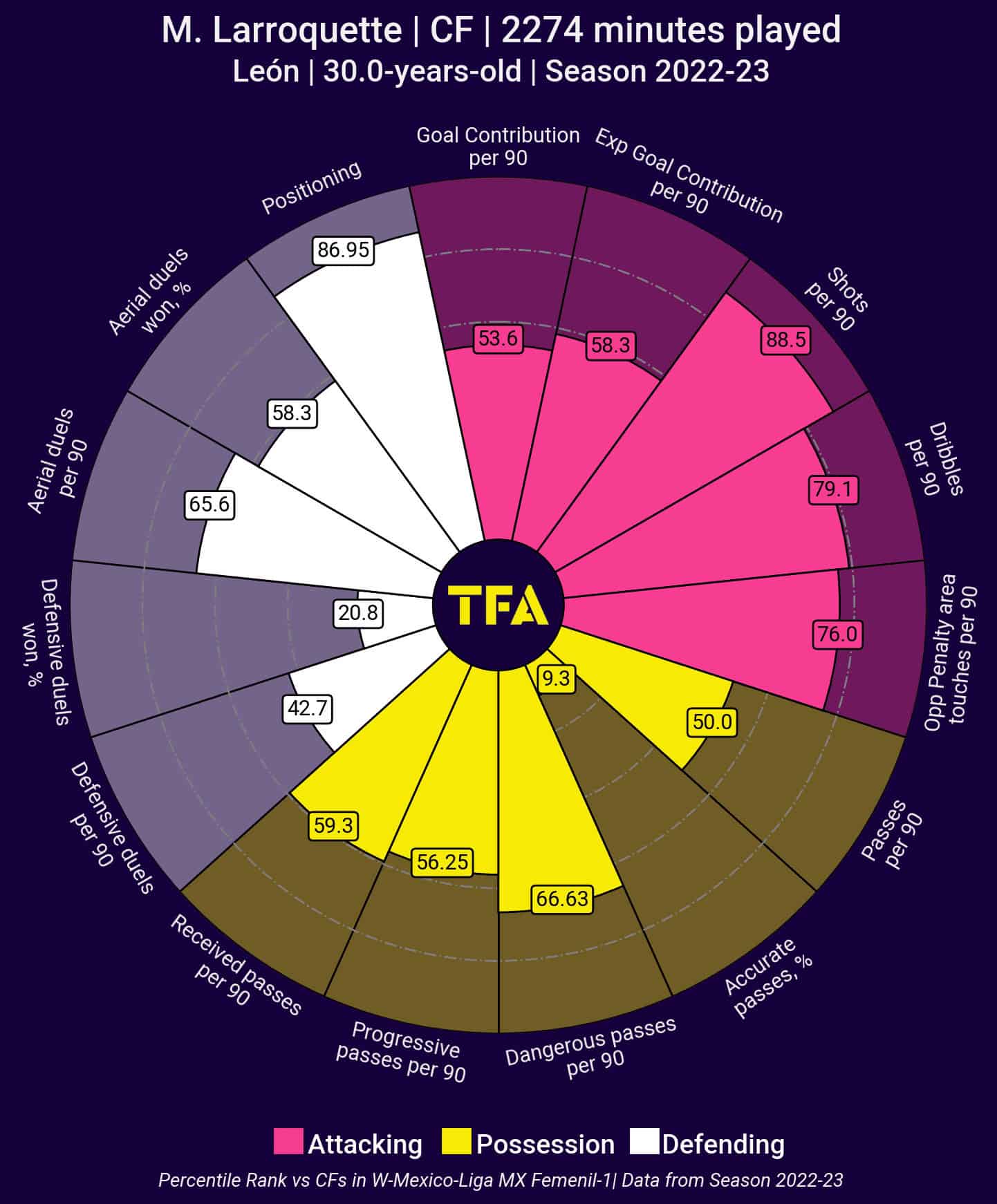
With three goals in Argentina’s last five matches, 30-year-old striker Mariana Larroquette will be essential if Argentina are to experience success at this summer’s tournament. The León striker is also able to play as a #10 or out wide in Argentina’s 4-4-2 or 4-2-3-1 formation.
Above we can see her pizza chart from her 2022/23 season at León. The data tells us that she likes to take lots of shots and opposition penalty area touches per 90 minutes. She is also able to make a high number of dribbles which could be important if Larroquette is deployed in a wider position for Argentina. Larroquette also makes a good number of progressive passes and dangerous passes per 90 minutes. This could be the key to unlocking stubborn defences, especially if she plays just behind the striker and is able to receive the ball between the opponent’s defensive and midfield lines.
We can see from the data that Larroquette successfully attempts an above-average number of aerial duels per 90 minutes, which could give her the edge when looking to receive crosses from Argentina’s wingers if she is positioned in the opponent’s penalty area. She also has very good positional awareness, which will be important if she is asked to play out wide or drop deeper to help Argentina out defensively when they have settled into their low block.
Tournament prediction
As previously mentioned, Argentina have yet to go past the group stage at the FIFA Women’s World Cup before. They are, in fact, still searching for their first victory at a World Cup finals competition.
With Sweden big favourites to top Group G points against Italy and South Africa look to be essential to ensuring Argentina reach the knockout stages of the Women’s World Cup for the first time. Although history certainly isn’t on Argentina’s side, their experience from four years ago and relative success at last year’s Copa América Femenina will make them confident of progressing past the group stage. With their recent form and mix of youth and experience in their squad, can this be the year that Argentina finally reach the knockout stages of the FIFA Women’s World Cup for the first time?

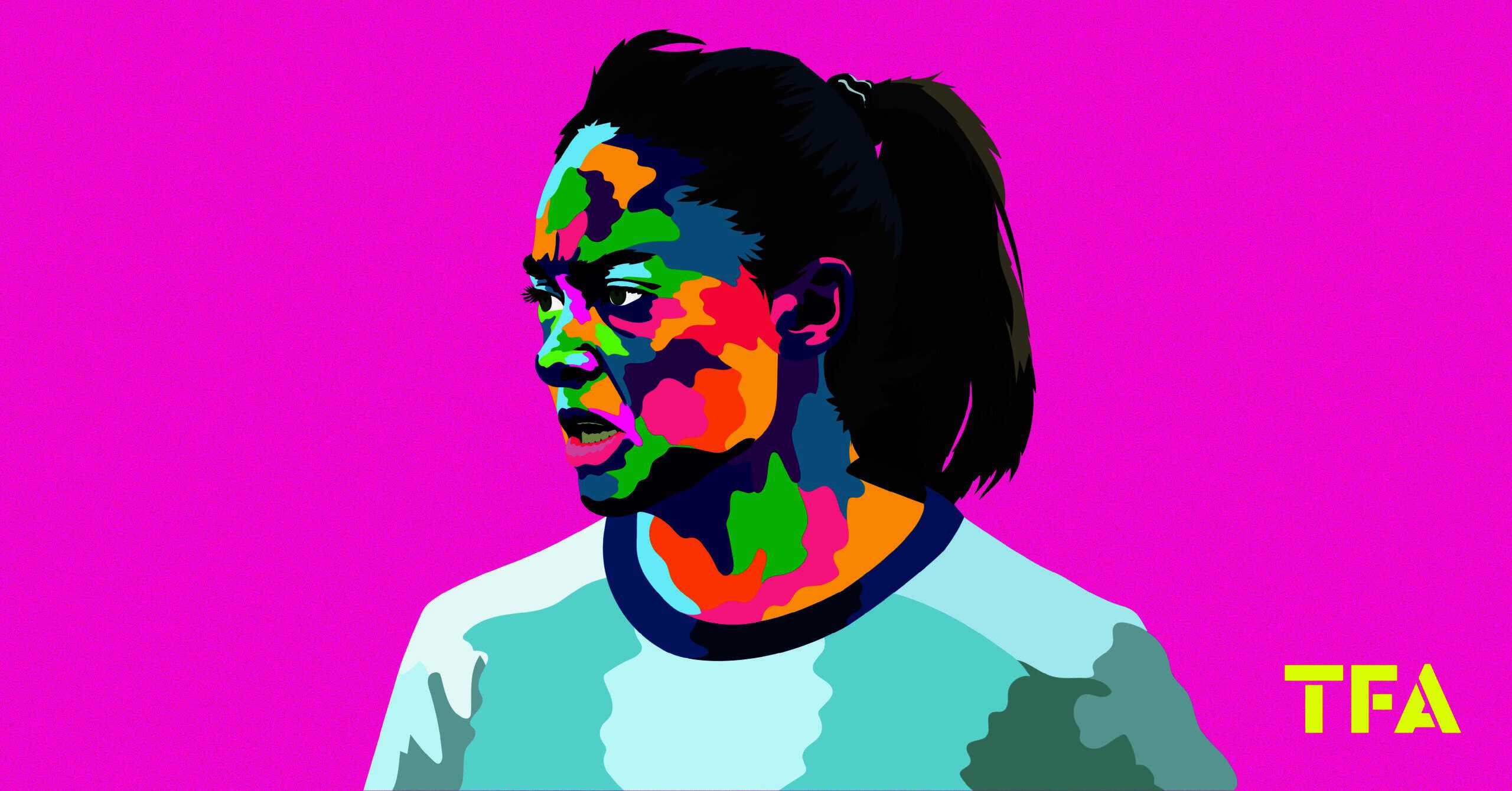



Comments